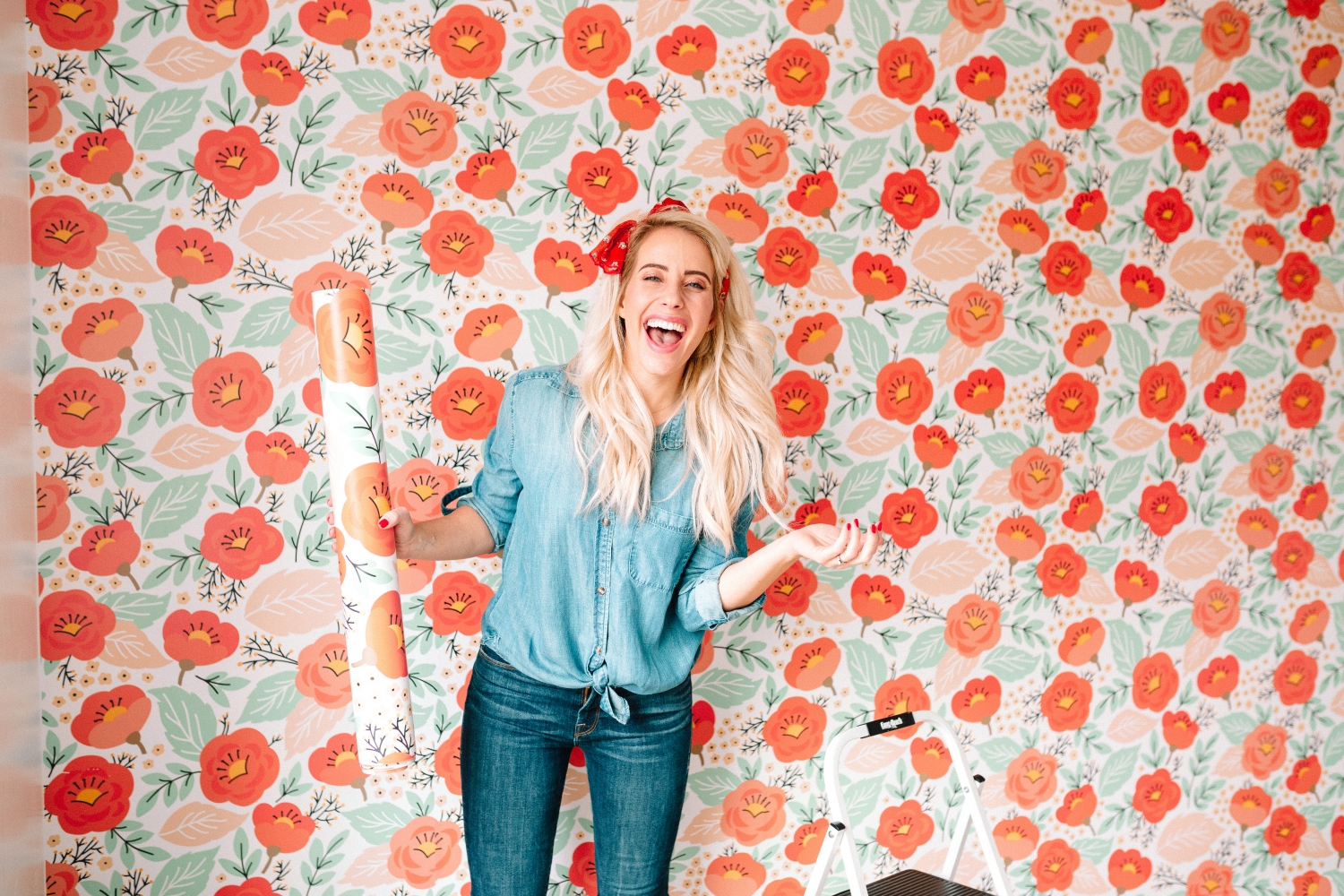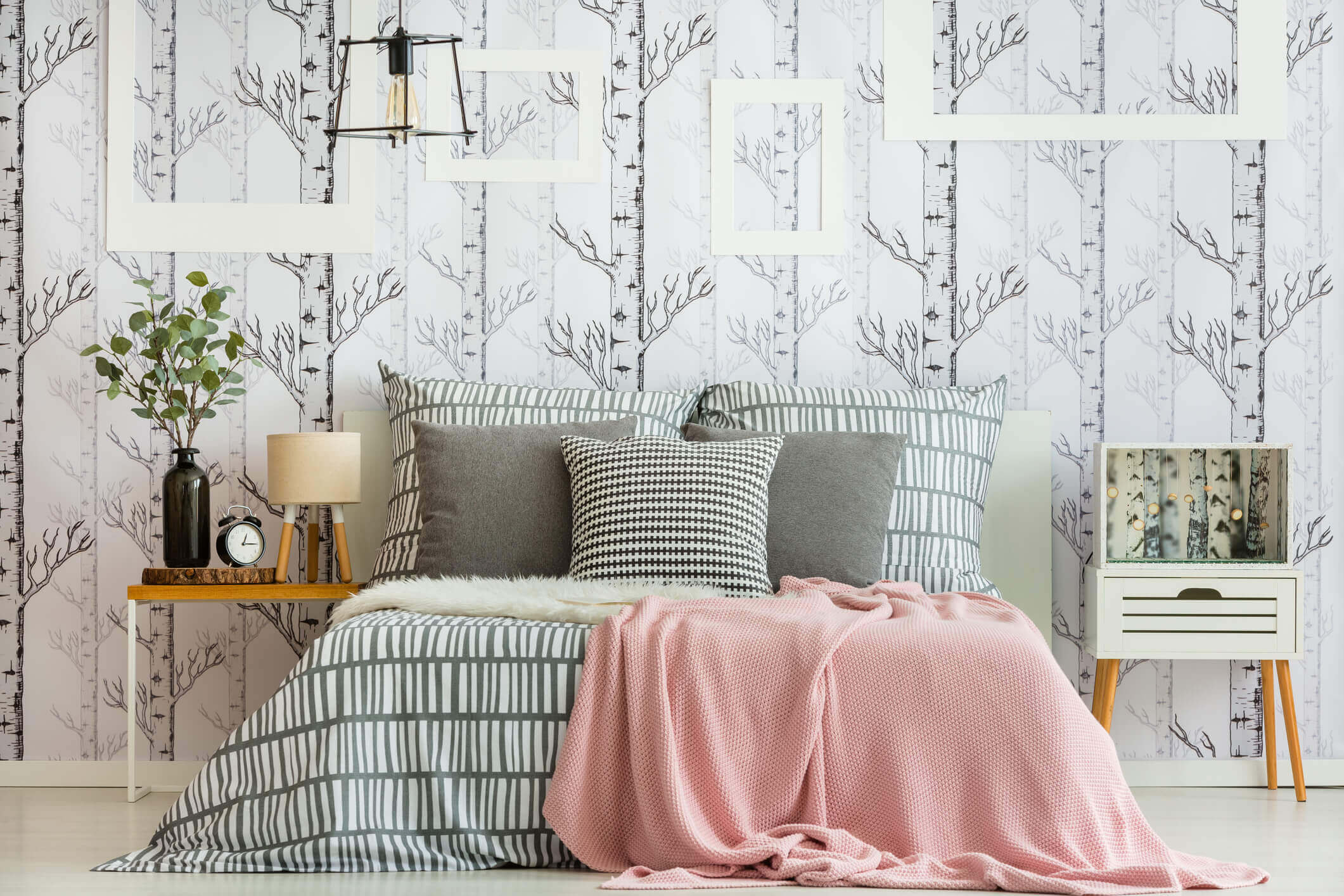Types of DIY Wallpaper: Diy Wallpaper For Bedroom

Embarking on a DIY wallpaper project can be an exciting way to transform your bedroom’s aesthetic. With various types of DIY wallpaper available, it’s crucial to choose the option that best suits your needs and style. This guide will explore the most popular types of DIY wallpaper, examining their pros and cons to help you make an informed decision.
Peel-and-Stick Wallpaper
Peel-and-stick wallpaper is a popular choice for DIY enthusiasts due to its ease of application and removability. It features an adhesive backing that allows you to simply peel off the paper and stick it to your wall.
- Pros:
- Easy to apply and remove without damaging walls.
- No need for messy paste or glue.
- Available in a wide variety of patterns, colors, and textures.
- Cost-effective compared to traditional wallpaper.
- Cons:
- May not be as durable as traditional wallpaper, especially in high-traffic areas.
- Can be prone to peeling or bubbling if not applied correctly.
- May not be suitable for all wall surfaces, such as textured walls.
Removable Wallpaper
Removable wallpaper offers a similar level of ease of application as peel-and-stick wallpaper, but it uses a different adhesive technology. This type of wallpaper utilizes a temporary adhesive that allows for easy removal without leaving any residue.
- Pros:
- Easy to remove and reposition.
- Leaves no residue on the wall.
- Suitable for renters or those who want to change their decor frequently.
- Available in a variety of styles and patterns.
- Cons:
- May not be as durable as traditional wallpaper.
- Can be more expensive than peel-and-stick wallpaper.
Textured Wallpaper
Textured wallpaper adds depth and dimension to your walls, creating a tactile and visually appealing effect. It comes in a variety of textures, from subtle to bold, allowing you to create different moods and styles in your bedroom.
- Pros:
- Adds visual interest and texture to walls.
- Can help to disguise imperfections in the wall.
- Available in various textures, from subtle to bold.
- Cons:
- Can be more challenging to apply than smooth wallpaper.
- May require special tools and techniques for installation.
Patterned Wallpaper
Patterned wallpaper is a versatile option that can transform the look of your bedroom instantly. From floral prints to geometric designs, patterned wallpaper offers a wide range of choices to match any style.
- Pros:
- Adds a statement piece to your bedroom.
- Available in a vast array of patterns and colors.
- Can create a focal point or accent wall.
- Cons:
- Can be overwhelming if not used carefully.
- May require more planning and precision during installation.
Comparison of DIY Wallpaper Types
| Type | Ease of Application | Durability | Aesthetic Appeal | Suitability for Bedroom Styles |
|---|---|---|---|---|
| Peel-and-Stick | Easy | Moderate | Wide variety | Modern, minimalist, eclectic |
| Removable | Easy | Moderate | Wide variety | Transitional, contemporary, bohemian |
| Textured | Moderate | High | Unique and tactile | Rustic, farmhouse, industrial |
| Patterned | Moderate to High | High | Statement-making | Traditional, eclectic, modern |
DIY Wallpaper Techniques and Tips

Transforming your bedroom with DIY wallpaper is a fun and affordable way to personalize your space. However, achieving a professional finish requires careful planning and execution. This guide will walk you through the essential techniques and tips for successful DIY wallpaper installation.
Preparing the Walls
Before you start applying wallpaper, ensure your walls are clean, smooth, and free of any imperfections. This step is crucial for a seamless finish and to prevent the wallpaper from peeling or bubbling.
- Clean the walls: Use a damp cloth and mild detergent to remove dust, dirt, and grease. Allow the walls to dry completely before proceeding.
- Fill any holes or cracks: Use spackling paste to fill in any holes or cracks in the walls. Allow the paste to dry completely and then sand it smooth with fine-grit sandpaper.
- Prime the walls: Apply a coat of primer to the walls to create a smooth, even surface for the wallpaper to adhere to. This also helps to prevent the wallpaper from absorbing too much paste and becoming warped.
Measuring and Cutting, Diy wallpaper for bedroom
Accurate measurements are essential for a perfect fit.
- Measure the walls: Use a measuring tape to determine the height and width of each wall section you want to cover with wallpaper. Add a few inches to the measurements to allow for trimming.
- Cut the wallpaper: Using a sharp utility knife and a cutting mat, cut the wallpaper to the required size. Ensure the cuts are straight and precise.
- Align the pattern: If your wallpaper has a pattern, make sure to align the pattern carefully before pasting each piece. This ensures a seamless look and prevents any mismatches.
Applying the Wallpaper
- Apply wallpaper paste: Spread a thin, even layer of wallpaper paste on the back of the wallpaper using a brush or roller. Avoid applying too much paste, as this can cause the wallpaper to bubble or warp.
- Position the wallpaper: Carefully position the wallpaper on the wall, starting from the top and working your way down. Use a level to ensure the wallpaper is straight.
- Smooth out the wallpaper: Use a smoothing tool or a clean cloth to smooth out any air bubbles or wrinkles. Work from the center of the wallpaper outwards to avoid tearing it.
- Trim the excess: Once the wallpaper is in place, use a sharp utility knife to trim any excess along the edges. Use a ruler or a straight edge to ensure a clean cut.
Common Mistakes to Avoid
- Not cleaning the walls properly: Dirt and grease can prevent the wallpaper from adhering properly.
- Using too much paste: Excess paste can cause the wallpaper to bubble or warp.
- Not smoothing out air bubbles: Air bubbles can trap moisture and cause the wallpaper to peel or bubble.
- Not aligning the pattern correctly: Misaligned patterns can create an uneven and unprofessional look.
- Not trimming the excess carefully: Uneven trimming can leave ragged edges and ruin the overall look.
Tools and Materials
- Wallpaper paste: Choose a paste specifically designed for the type of wallpaper you are using.
- Smoothing tool: This helps to remove air bubbles and wrinkles.
- Level: Ensure the wallpaper is straight and even.
- Utility knife: Used for cutting the wallpaper.
- Cutting mat: Protects your work surface from scratches.
- Measuring tape: Accurate measurements are crucial for a perfect fit.
- Brush or roller: Apply the wallpaper paste evenly.
- Clean cloth: Used for smoothing the wallpaper and wiping up excess paste.
Creative DIY Wallpaper Ideas for Bedrooms
/11Dalmation-a57e528efd05431faeaf9f7af718a4d0.jpg)
Transforming your bedroom into a haven of comfort and style doesn’t have to involve expensive renovations. DIY wallpaper offers a creative and budget-friendly solution to personalize your space and create a unique ambiance. From accent walls to headboards and decorative elements, the possibilities are endless.
DIY wallpaper allows you to express your personal style and create a truly unique bedroom environment. By incorporating different patterns, textures, and colors, you can craft a cohesive and personalized design that reflects your taste and personality.
Accent Walls
Accent walls are a popular way to add visual interest and personality to a bedroom. They can be used to highlight a particular feature, such as a headboard or a window, or to create a focal point in the room.
- Geometric patterns: Geometric patterns, such as stripes, chevrons, and triangles, are a versatile choice for accent walls. They can be used to create a modern, contemporary look or a more traditional, classic feel, depending on the colors and scale of the pattern.
- Floral prints: Floral prints are a classic choice for bedrooms, and they can be used to create a romantic, feminine, or whimsical atmosphere. You can choose from a variety of floral patterns, from delicate and subtle to bold and vibrant.
- Textured wallpaper: Textured wallpaper adds depth and dimension to a bedroom. It can be used to create a cozy and inviting atmosphere or a more dramatic and sophisticated look. Textured wallpaper is available in a variety of materials, including fabric, wood, and even metal.
Headboards
DIY wallpaper can be used to create unique and stylish headboards that transform the look and feel of your bedroom.
- Fabric wallpaper: Fabric wallpaper is a great choice for headboards, as it provides a soft and luxurious look and feel. You can use a variety of fabrics, such as velvet, linen, or silk, to create a headboard that complements the overall style of your bedroom.
- Patterned wallpaper: Patterned wallpaper can be used to create a bold and eye-catching headboard. You can choose from a variety of patterns, such as stripes, polka dots, or geometric designs, to create a headboard that reflects your personal style.
- DIY headboard with wallpaper: Create a headboard from a simple wooden frame and cover it with your favorite wallpaper. This is a great way to add a personal touch to your bedroom and create a headboard that perfectly matches your decor.
Decorative Elements
DIY wallpaper can also be used to create a variety of decorative elements for your bedroom, such as:
- Wall art: Create unique wall art by using wallpaper to cover canvases, wooden frames, or even mirrors. You can choose from a variety of patterns and textures to create wall art that reflects your personal style.
- Storage boxes: Decorate storage boxes with wallpaper to create a cohesive and stylish look in your bedroom. This is a great way to add a personal touch to your storage solutions and keep your belongings organized.
- Nightstands: Transform plain nightstands by covering them with wallpaper. This is a simple and affordable way to add a touch of personality to your bedroom furniture.
